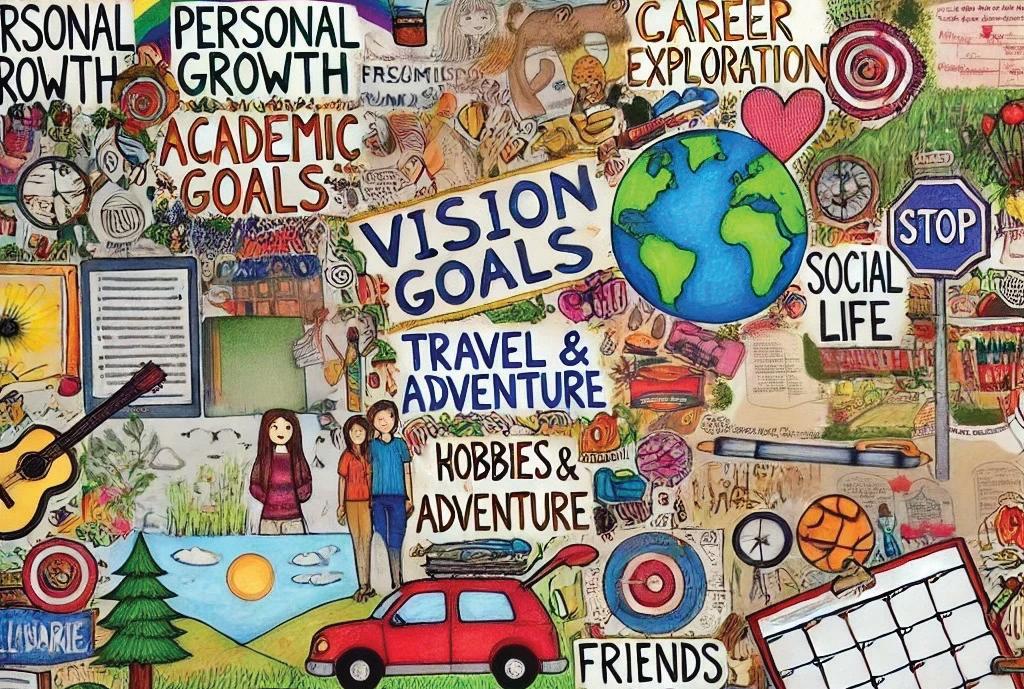MODULE
© The Examcraft Group | Reproduction not permitted
Why Transition Year is Worth It

© The Examcraft Group | Reproduction not permitted
Why Transition Year is Worth It
YOU ARE NOW STARTING YOUR THREE-YEAR SENIOR CYCLE PROGRAMME.
Transition Year (TY) is a year where you get to step away from textbooks and exams and focus on real-life experiences, personal growth and figuring out what you want for your future. Transition Year helps you become more independent, creative and confident while giving you the chance to try new things, meet new people, and explore possible career paths.
WHY TRANSITION YEAR IS WORTH IT
14
2
A Break from the Pressure of Exams
Transition Year is a chance to breathe after the Junior Cycle and explore new ways of learning such as working on projects, taking part in workshops and learning through hands-on experiences.
Learning Beyond the Classroom
You get to try new activities, take part in trips, gain work experience and develop skills that will help you in college, employment, or wherever life takes you.
3
Becoming More Independent and Confident
Transition Year is designed to help you grow as a person. You’ll gain confidence in yourself by stepping outside your comfort zone, working on group projects and leading initiatives.
5
Figuring Out Your Career Path
One of the biggest benefits of Transition Year is getting a taste of the working world. Through work experience placements and career talks, you’ll have the chance to explore different jobs and industries.
Making a Difference in the Community
Transition Year also focuses on giving back. You’ll have opportunities to volunteer, work on community projects and take part in social initiatives that make a real impact. This helps build empathy and teaches you about the importance of contributing to society.
Transition Year, being a part of Senior Cycle, is designed to help you develop key competencies that will allow you to grow and thrive intellectually, personally, socially, morally and physically. These competencies, which you will be developing over the next three years, are:
Thinking and solving problems
Managing learning and self
Cultivating wellbeing
KEY COMPETENCIES IN SENIOR CYCLE
Participating in society
Working with others
Being creative
Communicating
Integrated within these competencies are the fundamental competencies of literacy and numeracy.
There are three elements to a competency:
The Senior Cycle is designed so that you will develop the knowledge, skills, values and dispositions associated with each competency across all your subjects, helping you to become an enriched, engaged and competent learner. This will ensure that you and your teachers make meaningful connections between and across different areas of learning, thus improving and embedding your overall learning.
Why Transition Year is Worth It
Transition Year is all about developing skills that will help you both in school and in life. These fall into four main categories: Personal Growth, Learning Skills, Social and Community Engagement and Career Exploration.
Transition Year gives you an opportunity to mature socially and emotionally while developing in areas such as health and wellbeing, autonomy, identity, empathy and leadership.
Increased self-confidence andPrioritisinghealth wellbeing settingPersonalgoalmakingBetterdecision- Greater task perseverance
Seeing challenges as growth AdaptingtosocialsettingsMoreempathetic interactions
INDICATORS THAT YOU ARE DEVELOPING IN THIS AREA
Owningbehaviours anddecisions
Increased leadership and initiative
Self-expression through projects
Health and wellbeing activities
Personal growth portfolio
Reflecting on personal goals
Opportunities to present publicly
Teamwork and collaborative projects
List three areas of personal growth that you would like to develop during the year.
1 2 3
What activities would you like to participate in to help you to grow in these areas?
Transition Year gives you an opportunity to mature socially and emotionally while developing in areas such as health and wellbeing, autonomy, identity, empathy and leadership.
Building on your previous experiences, you’ll develop in Senior Cycle strategies for learning that work best for you now and into the future.
Exploring personal interests lifelongAppreciatinglearning mistakesLearningfrombackValuingfeedmore learningIndependent growth
Motivated and enjoying learning Regular learning goal review Improveddigitalskills
INDICATORS THAT YOU ARE DEVELOPING AS A LEARNER
Tryingdiverse strategies Bettercommunicationskills
Clearer idea expression
POSSIBLE EXPERIENCES TO SUPPORT YOU BEING A BETTER LEARNER
Senior Cycle subject sampling Personally driven learning opportunities Transition support to Senior Cycle Learning progress portfolio Challenging and manageable projects Taking up a new language
Embracing learning opportunities
I have found learning enjoyable when:
I learn on my own if:
If I avoid learning it is because:
Three things I enjoy about school are:
Two areas where you would like to develop your learning ability during Transition Year: 1 1 1 2 2 2 3 3
Three areas where you would like to focus your learning during Transition Year:
It is hoped that during the year you will make a positive difference to your school, community and society. You will live responsibly and exercise your rights as a local, national and global citizen in ethical and sustainable ways.
THAT YOU ARE DEVELOPING IN CIVIC AND COMMUNITY ENGAGEMENT Initiative in community Activecitizenshipgoal-setting Co-operativeteamworkskills
Respectful relationships and care dignityAppreciationofanddiversity andStrongerempathy belonging complexityEngagingwith Living sustainablymore CreativeandculturalinvolvementContributingtojustice
Clearer understanding of global issues Work with organisations Community volunteering opportunities
POSSIBLE EXPERIENCES TO SUPPORT CIVIC AND COMMUNITY ENGAGEMENT
Think of a way you can positively impact your community during TY. It could be:
• Organising a charity event
• Volunteering for a cause
• Starting an awareness campaign
Use the space below to brainstorm your social impact project.
What positive differences would you like to make to your community during TY?
You will explore diverse future pathways, gaining first-hand workplace experience and developing career-related competencies. Understandingeducationandcareerlinks Self-awarenessofinterests Regular careergoal review Critical career research skills vocationalEnhanced skills improvementexperienceWorkplace
INDICATORS THAT YOU ARE DEVELOPING IN THIS AREA
Work and awarenessenterprise
POSSIBLE EXPERIENCES TO DEVELOP CAREER EXPLORATION
Work placements
Diverse guest speakers
List three careers you would like to explore or find out more about during the year.
How do you plan to find out more about these? 1 2 3 Why Transition Year is Worth
To help you make the most of your Transition Year, it is important that you reflect on what you want to get out of the programme. Here are some exercises to get you thinking about your goals, skills and aspirations for the year ahead.
(Personal Growth – Planning)
Create a vision board using words, images and drawings to represent what you want to achieve in TY. Include new experiences you want to try, skills you want to develop, career paths you’d like to explore and personal growth goals.
















































































































































Write a letter to yourself about what you hope to gain from TY. Include:
• What you're most excited about
• Any fears or worries you have
• Personal challenges you want to overcome
• Your goals for the year.
At the end of TY, read your letter and see how much you’ve grown!
Dear Me,
Right now, I’m about to start my Transition Year, and I have so many thoughts running through my head. This letter is to remind myself of what I hope to gain from this year.
I’m really excited about the chance to try new things and step outside my comfort zone. I can’t wait to go on our outdoor adventure trip and the cultural exchange trip to France as well as the team-building retreat. I’m also looking forward to taking part in organising a school fundraiser, participating in a business mini-company, and working on a creative media project. My work experience placements are big for me. I hope to spend time in a digital marketing firm and a community outreach programme to get a feel for different career options.
At the same time, I do have a few worries. What if I don’t push myself enough? What if I stick to what’s comfortable instead of trying new challenges? I hope when I read this letter at the end of the year, I can say that I gave it my best shot, even when it was scary.
One of my biggest personal challenges is confidence. I want to become more comfortable speaking in front of people, sharing my ideas, and stepping into leadership roles. I also want to learn how to manage my time better and be more independent. If I can achieve even a little bit of this by the end of TY, I’ll consider that a success.
So, my top five goals for the year are:
• Gain real-world experience through my work placements in digital marketing and community outreach.
• Build my confidence in social situations.
• Try at least one new activity that challenges me, like debating or acting in a school play.
• Make a positive impact in my community through volunteering or school projects.
I hope that at the end of the year I can read this with a sense of pride and accomplishment. I hope I will take every opportunity that comes my way. No matter how the year turns out, I hope I make the most of it and have fun.
You’ve probably heard people describe Transition Year as “a doss year” where you get to sit around and do nothing, but do all of the learning and activities we’ve looked at sound like nothing?!
you get to go on school trips and have lots of fun, but you’re learning as you do so. Transition Year provides you with unique experiences and opportunities to learn in a way that you never have before. You can then take these new tools and skills on to your Leaving Certificate studies and on into the workplace.
If you’re looking for advice on any of the projects on your TY programme, need help with work experience or are just looking for some ideas, www.ty.ie is a good place to start.
The most important thing to remember about Transition Year is that you get out of it what you put in. Transition Year doesn’t have the pressure of big exams and instead focuses on participation, ongoing assessment and selfevaluation. It puts in your hands the responsibility of your own progress and learning by letting you keep a record of what you have learned along with portfolios and exhibitions of your work.
What sort of person will you be after Transition Year? Will you have skills and responsibilities that you thought you’d never possess? Will people look to you for help/advice? TY gives you the opportunity to excel at something outside of exams and books, so get involved — you’ll surprise yourself!
89F Lagan Road, Dublin Industrial Estate, Glasnevin, Dublin 11, Ireland, D11 F98N.
info@examcraftgroup.ie www.examcraftgroup.ie 01-8081494